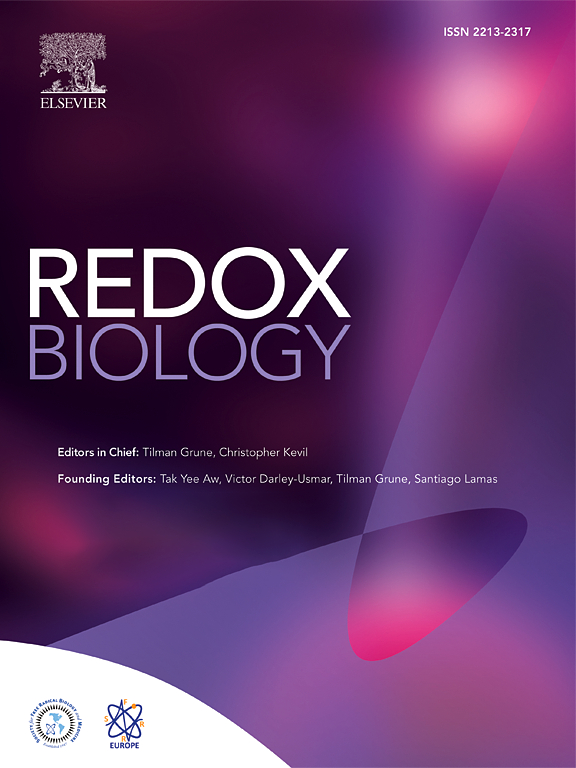槲皮素通过调节铁蛋白吞噬和细胞内铁外排抑制铁下垂,减轻LPS/ ie - dap诱导的肝损伤
IF 11.9
1区 生物学
Q1 BIOCHEMISTRY & MOLECULAR BIOLOGY
引用次数: 0
摘要
瘤胃生态失调引起的肝损伤在奶牛中很普遍,但其潜在机制仍不完全清楚。铁性死亡是一种新发现的程序性细胞死亡形式,不同于细胞凋亡和坏死,在各种肝脏疾病中都有涉及。本研究采用脂多糖(LPS)和γ- d -谷氨酰-中二氨基苯甲酸(iE-DAP)分别建立牛肝细胞和小鼠肝损伤模型。我们观察到,单独使用非细胞毒性的iE-DAP不影响脂质过氧化或GPX4,但会加重lps诱导的铁下垂和肝细胞损伤。值得注意的是,LPS和iE-DAP (LPS/iE-DAP)诱导的肝细胞损伤通过铁下垂抑制剂铁抑素-1 (fer1)的干预得到缓解。在机制上,激活的IL-6/STAT3信号通路介导LPS/ ie - dap诱导的铁下垂。通过IL-6和STAT3的下调或药物干预抑制IL-6/STAT3,可减少铁离子积累,减轻铁致细胞死亡。进一步的研究发现,IL-6/STAT3信号通路增强了铁蛋白吞噬和铁输出受损。无论是通过敲低NCOA4来破坏铁蛋白自噬,还是通过敲低HAMP来恢复铁输出,都可以缓解细胞内铁过载,抑制铁凋亡。具体来说,LPS/iE-DAP处理增加了hepcidin和铁转运蛋白之间的相互作用,促进铁转运蛋白的泛素化和降解,从而阻断铁的外排。此外,我们提供了一些证据来证明槲皮素预处理通过靶向IL-6/STAT3信号通路减少肝铁积累,从而减轻LPS/ ie - dap诱导的铁下垂和肝损伤,而添加重组牛IL-6可以逆转这一作用。综上所述,我们认为LPS/ ie - dap通过调节IL-6/STAT3/铁蛋白依赖性铁释放和IL-6/STAT3/hepcidin/铁蛋白依赖性铁输出引发铁凋亡,而槲皮素可通过IL-6/STAT3信号通路抑制铁凋亡,从而减轻这种肝损伤。本研究对瘤胃生态失调诱导肝损伤的机制提供了新的见解,并为瘤胃生态失调诱导肝损伤提供了一个有前景的解决方案。本文章由计算机程序翻译,如有差异,请以英文原文为准。

Quercetin alleviates LPS/iE-DAP-induced liver injury by suppressing ferroptosis via regulating ferritinophagy and intracellular iron efflux
Ruminal dysbiosis-induced liver injury is prevalent in dairy cows, yet its underlying mechanisms remain incompletely understood. Ferroptosis, a newly identified form of programmed cell death distinct from apoptosis and necrosis, has been implicated in various liver diseases by emerging studies. In the present study, lipopolysaccharide (LPS) and γ-D-glutamyl‐meso‐diaminopimelic acid (iE-DAP) were employed to establish in vitro and in vivo models of liver injury using bovine hepatocytes and mice, respectively. It was observed that noncytotoxic iE-DAP alone did not influence lipid peroxidation or GPX4, but exacerbated LPS-induced ferroptosis and hepatocyte injury. Notably, co-treatment with LPS and iE-DAP (LPS/iE-DAP)-induced hepatocyte injury was mitigated by intervention with the ferroptosis inhibitor ferrostatin-1 (Fer-1). Mechanistically, the activated IL-6/STAT3 signaling pathway was found to mediate LPS/iE-DAP-induced ferroptosis. Suppression of IL-6/STAT3, either through IL6 and STAT3 knockdown or pharmacological intervention, reduced Fe2+ accumulation and alleviated ferroptotic cell death. Further investigations identified that IL-6/STAT3 signaling enhanced ferritinophagy and impaired iron export. Either disrupting ferritinophagy by knocking down NCOA4 or restoring iron export via HAMP knockdown relieved intracellular iron overload and inhibited ferroptosis. Specifically, LPS/iE-DAP treatment increased the interaction between hepcidin and ferroportin, promoting ferroportin ubiquitination and degradation, thereby blocking iron efflux. Furthermore, we provided several evidence to prove that quercetin pretreatment alleviated LPS/iE-DAP-induced ferroptosis and liver injury by decreasing hepatic iron accumulation via targeting the IL-6/STAT3 signaling in vitro and in vivo, effects reversed by the addition of recombinant bovine IL-6. Based on these findings, we concluded that LPS/iE-DAP-induced liver injury by triggering ferroptosis through regulating IL-6/STAT3/ferritinophagy-dependent iron release and IL-6/STAT3/hepcidin/ferroportin-dependent iron export, while quercetin could alleviate this liver injury by inhibiting ferroptosis via IL-6/STAT3 signaling pathway. This study provides novel insights into the mechanisms whereby ruminal dysbiosis induces liver injury and presents a prospective solution for ruminal dysbiosis-induced liver injury.
求助全文
通过发布文献求助,成功后即可免费获取论文全文。
去求助
来源期刊

Redox Biology
BIOCHEMISTRY & MOLECULAR BIOLOGY-
CiteScore
19.90
自引率
3.50%
发文量
318
审稿时长
25 days
期刊介绍:
Redox Biology is the official journal of the Society for Redox Biology and Medicine and the Society for Free Radical Research-Europe. It is also affiliated with the International Society for Free Radical Research (SFRRI). This journal serves as a platform for publishing pioneering research, innovative methods, and comprehensive review articles in the field of redox biology, encompassing both health and disease.
Redox Biology welcomes various forms of contributions, including research articles (short or full communications), methods, mini-reviews, and commentaries. Through its diverse range of published content, Redox Biology aims to foster advancements and insights in the understanding of redox biology and its implications.
 求助内容:
求助内容: 应助结果提醒方式:
应助结果提醒方式:


